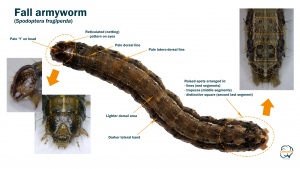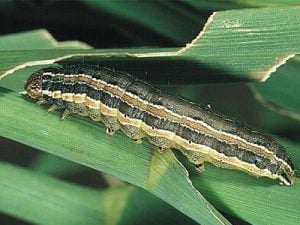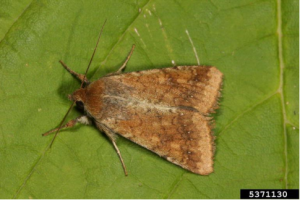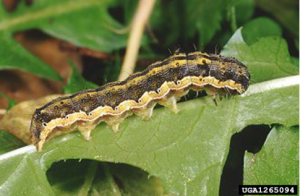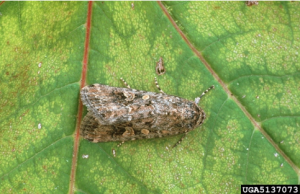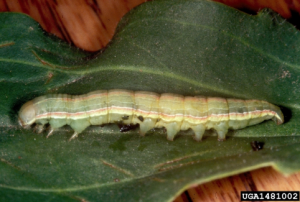Spodopetera frugiperda, better known as Fall armyworm (FAW), is native to the tropical and sub-tropical regions of the Americas and can be devastating to crops. The larvae of Fall armyworm have a large host range including maize, pulses, sorghum, soybean, winter cereals, peanuts, sunflowers, sugar cane, cotton, watermelon and rockmelon. Since 2016 FAW has spread quickly through Africa, the Indian subcontinent, China and south-east Asia and was detected in Queensland in January 2020. The pest has continued to spread, with national biosecurity organisations deeming it as unfeasible to eradicate.
The adult moths are most active during warm, humid evenings, and all life stages struggle to survive in temperatures below 12°C and will not survive frost events. To complete one generation, it is estimated that a minimum of 600 degree days, above 12°C, are required. Therefore, in Victoria, FAW is likely to be more of an issue during the warmer months, when temperatures are conducive to migration.
Fall armyworm egg masses are commonly seen on the upper surface of leaves.
With summer approaching, growers are advised to be vigilant and monitor crops for Fall armyworm. This article is designed to assist you in identifying FAW on your property.
Sightings of suspected eggs, larvae and moths should be reported immediately to the Exotic Plant Pest Hotline on 1800 084 881.
A reported sighting can also be created in the MyPestGuide, which will alert authorities.
Note: Although FAW is well known for its ability to utilise prevailing winds to travel long distances, it is also effective at hitchhiking on humans, animals, machinery and infected plant material. Therefore, in addition to maintaining good on-farm hygiene practices, growers should also be vigilant in maintaining good hygiene during the movement of people, livestock and vehicles between properties.
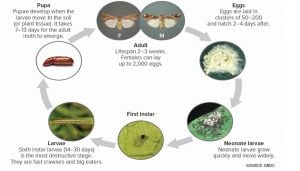
Lifecycle of Fall armyworm. Diagram source: Grains Research Development Corporation. Image acknowledgements: Lyle Buss and James Castner, University of Florida and Matt Bertone, NCSU.
Fall armyworm can be easily misidentified as some of the other moth species that reside in Victoria including Common armyworm, Southern armyworm, Inland armyworm, Corn earworm, Native budworm and Lesser armyworm.
In the below text we separate out each of these invertebrates with images to assist you in trying to determine which may be present in your paddock. Larvae of Fall armyworm, like many of the invertebrates mentioned below, vary in colour and some of the features are shared by other species. If you suspect or are unsure if you have fall armyworm, contact the Exotic Plant Pest Hotline on 1800 084 881.
Fall armyworm (Spodopetera frugiperda)
Fall armyworm can be identified by the ‘Y’ marking on the head area and the four large spots in a square formation on the tail end.
Common armyworm (Leucania convecta), southern armyworm (Persectania ewingii) and inland armyworm (Persectania dyscrita)
These three are difficult to distinguish, however, correct species identification in the field is generally not critical because their habits, type of damage and control are similar.
Larvae are generally green, brown or yellow with three parallel white longitudinal stripes running from the ‘collar’ behind the head, along the body to the tail end.
Helicoverpa armigera and Helicoverpa punctigera
Helicoverpa armigera also known as Corn earworm, Heliothis and Tomato grub, is light brown to red-brown, with numerous dark spots/blotches. The hind wings are pale with a dark band along the lower edge.
Larvae have darkish stripes along the body and bumpy skin with sparse stiff stout hairs and a sharp downward angle at the rear of the body.
Helicoverpa punctigera (native budworm) vary from the Corn earworm by the black hairs around the head and along the body, whereas the Corn earworm has white hairs around its head and black hairs along the body.

Larvae Helicoverpa puncitgera. Image: © State of Western Australia (Department of Primary Industries and Regional Development, WA) .
Lesser armyworm/beet armyworm (Spodoptera exigua)
They are greenish-brown cutworms, soft and bulging caterpillars with dark longitudinal stripes.
Further information links
http://www.cesaraustralia.com/sustainable-agriculture/pestnotes/insect/armyworm
https://grdc.com.au/resources-and-publications/resources/fall-armyworm
http://cesaraustralia.com/sustainable-agriculture/pestnotes/insect/Corn-earworm
Acknowledgments
Thank you to Julia Severi (cesar, Extension Scientist), Olivia Reynolds (cesar, Research Scientist), Tim Hurst (Agriculture Victoria, Chief Plant Health Officer unit), Antonette Walford (Agriculture Victoria, Chief Plant Health Officer unit) and Luise Fanning (Agriculture Victoria, Grains Pathology Services).
Feature Image: Fall armyworm (Spodoptera frugiperda)
Source: Russ Ottens, University of Georgia, Bugwood.org


